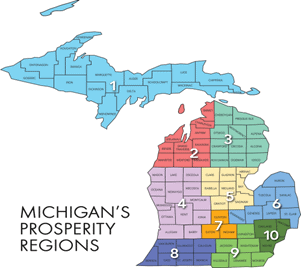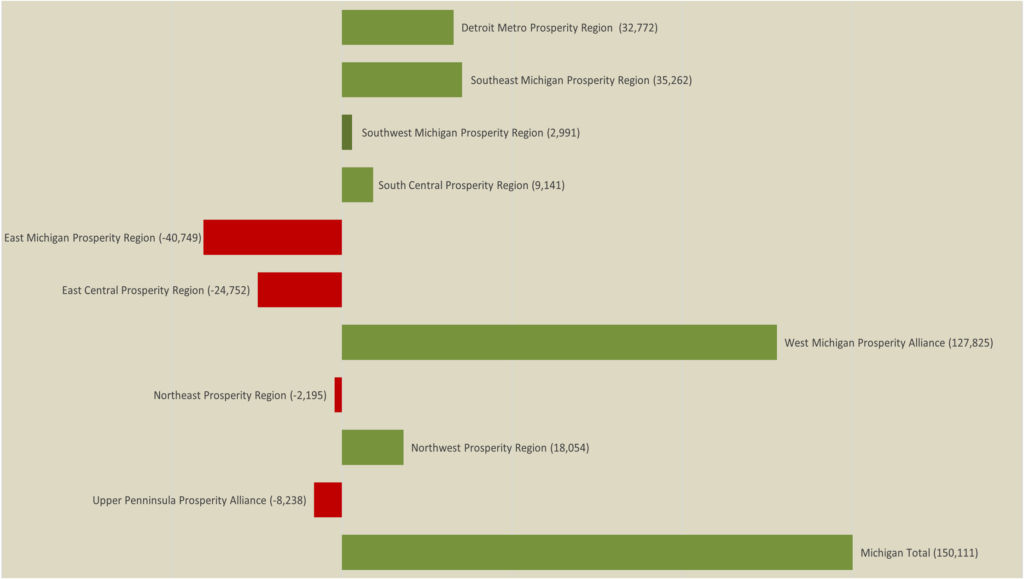- While statewide analyses of Michigan’s population growth show it to be stagnant, a regional analysis points to areas of strong growth in addition to areas of decline.
- The most effective strategy to achieve the vision of a prosperous Michigan may come by empowering regional efforts. The cumulative impact of regional economic growth and net-positive migration into the various regions of the state will aid in reaching statewide population and economic goals.
- Prosperity Region Boards are the ideal organizations to steer the vision of growth and economic prosperity championed by the Growing Michigan Together Council. Collaborative regional leadership will be better informed on how to address local challenges and benefit from opportunities presented.
Michigan’s stagnant population growth has been an ongoing concern for the state’s policymakers, educators, businesses, and residents. As an indicator of deteriorating prosperity, state policymakers are often challenged to find public policies that successfully encourage population growth, either by higher birth rates or by in-migration. For example, lower birth rates, and fewer new residents will bring fiscal uncertainty and a higher tax burden for the existing population. Low or negligible growth in population points to a less competitive economic future with fewer workers, lower income and sales tax revenues, falling school enrollment, and increased demand for services for aging adults.
In 2023, Governor Whitmer established the Growing Michigan Together Council (Council) and charged its members to propose a population goal and to identify policies to drive economic growth. In addition, the Council was to develop recommendations for transportation and water infrastructure investments, improve educational opportunities, and retain a skilled workforce. In their report issued in December 2023[1], the Council outlined a wide-ranging vision to reverse Michigan’s out-migration and increase economic growth to put the state on the road to long-term prosperity:
01. Establish Michigan as the Innovation Hub of the Midwest and America’s Scale-up State
02. Build a lifelong learning system focused on future-ready skills and competencies
03. Create thriving, resilient communities that are magnets for young talent
The vision would set Michigan on a path to be a top-ten state in population growth by 2050. Currently, the state has one of the lowest growth rates in the country. By recruiting innovative industries and high-skill talent to Michigan, as well as offering broad educational access and skill development for students, improved quality of life, and increased investments in transit, housing and infrastructure, the Growing Michigan Together Council developed recommendations to reverse those trends.
A Shared Strategy for Growth and Prosperity
The Council’s high-level vision lays out an admirable set of goals, but it misses a key component in its plan for future prosperity: the diversity of regions of the state. Tailoring strategies that leverage the unique demographic, cultural, economic, and infrastructure needs of the state’s regions is imperative to achieve durable success in becoming a top-ten state. While the Council acknowledged the importance of cooperation and engagement of municipal governments, the business community, and community organizations, the Council failed to recognize the critical role of regional efforts and the need for their engagement. Michigan is too big and diverse for a one-size-fits-all solution. It needs regional economic and demographic assessments, tailored growth strategies, and the buy-in of regional entities.
The government cannot bring this vision into reality on its own, so our vision must engage public, private, and philanthropic institutions that all have a role to play in building a better Michigan.
(Council Report, Page 5)
Policies to grow Michigan overall will not succeed unless its regions are prosperous. Delving deeper into why certain areas of the state are growing and how the social characteristics of their populations are changing will inform what specific investments will provide the greatest return.
For example, a small town in the Upper Peninsula with access to outdoor recreational activities may have a greater need for hotels, restaurants, housing for hospitality workers, or road improvements, rather than infrastructure for an industrial park. An industrial park could be a key strategy to invite an innovative manufacturer to a deteriorating urban area with vacant land, an available skilled workforce, and growing families. Coastal areas experiencing more intense climate-related storms may see a more urgent need for infrastructure investment to retain residents rather than more residential construction.
Regional Perspective
Examining public policy issues with a regional view is not new, and governments routinely use several variations of geographically defined districts to manage public services. Drinking water and wastewater management districts, for example, may cross over jurisdictional boundaries such as county or city lines because the local watershed may have a broader footprint. Admittedly, regional governance also comes with challenges – political, philosophical, and practical. However, the most effective strategy to achieve the vision of a prosperous Michigan is to begin at the regional level. Strong and successful communities, when taken together will build a growing Michigan. “If a series of small wins are informed by a strategic direction, the small wins can add up to a big win over time.” [Leadership for the Common Good, 2nd ed. Barbara C. Crosby and John M. Bryson, 2005, page 275] The cumulative impact of economic growth and net-positive migration into the various regions of the state will add up to statewide success.
Michigan Regional Planning and Economic Development Organizations
Regional governance or collaboration can take many forms: environmental, growth-based, political, or transit, for example. Such collaboration could be structured or ad-hoc, and include governmental, private, non-profit, or community groups. Michigan already has a myriad of established regionally focused organizations and efforts. Organizations working regionally on planning and economic development in Michigan range from planning councils established by law to privately funded community, economic, and workforce development organizations. These collaborative entities take a broad geographic and economic perspective on issues such as infrastructure investments, corporate recruitment, workforce training, and other topics that bleed over jurisdictional boundaries. State-established regional planning organizations (known as Councils of Government or economic development councils) help channel federal and state funding resources and manage service-sharing arrangements between local governments. In Michigan, three statutes establish regional planning and development authorities. However, these organizations are sometimes limited in their authority or scope of work.
- Regional Planning Act, 1945 PA 281
- County or Regional Economic Development Commission Act, 1966 PA 46.
- Metropolitan Councils Act, 1989 PA 292.
To close gaps in economic development strategies, private and corporate interests have formed non-profit organizations to focus on issues that they felt needed resources and attention. A few are listed here:
This has resulted in a hodgepodge of entities across the state with varying missions and reach. To address this inefficiency in the state’s regional planning structure, ten Prosperity Regions were established and seeded with state incentives to organize and develop strategic plans in 2014. (See Section 890 of Michigan Public Act 59 of 2013). By creating a formal collaborative structure for regional planning, the prosperity regions offered a table where community, governmental, and private stakeholders could work in tandem to address planning projects and economic development goals.
Michigan’s Prosperity Regions

Rather than using a top-down approach to implement a growth agenda, Prosperity Region boards are the ideal organizations to move the vision of the Growing Michigan Together Council forward. With their community presence, collaborative record, and capability to convene public and private efforts, Prosperity Region Councils are equipped to identify specific local challenges and opportunities. The roster of the Prosperity Region’s board could be adjusted to accommodate certain issues as needed.
An Illustration of Regional Differences – Population Growth
Prosperity Regions also provide generally accepted geographic boundaries for evaluating statewide economic and demographic data, which can be quite informative. The statewide figures, as used in the Council’s report, may have masked some important trends.
For example, the story on population changes by region tells a slightly different story than what is summarized in the Council’s report. The population trends on a statewide basis point show a story of a stagnant population level in Michigan. However, if the data is analyzed regionally, there is a different story to be told.
According to the most recent estimated county data released by the U.S. Census (Vintage 2023), Michigan’s population is growing markedly in areas on the western side of the state. In addition, the Upper Peninsula counties of Marquette and Houghton are showing growth in population, post-pandemic. However, counties in southeastern Michigan show a significant decline in population due to the population loss in Wayne County.
Population Changes in Michigan by Prosperity Region (2010-2023)

Annual Estimates of the Resident Population for Counties in Michigan: April 1, 2020, to July 1, 2023 (CO-EST2023-POP-26) Source: U.S. Census Bureau, Population Division, Release Date: March 2024, and Michigan Senate Fiscal Agency, Michigan Population by County (retrieved July 29, 2024).
These disparate regional county population trends are begging for adapted strategies. Statewide policies and programs will miss the mark. Strategies to sustain and support growth in areas with population increases will be different than tactics to reverse population declines in Bay County or Wayne County for example.
When Prosperity Regions Should Be Flexible
It is also important to point out that efforts to tackle issues at a regional level should maintain flexibility and allow for modifications of what defines a region or an area – county boundaries may not be appropriate in all circumstances. In planning for such services that serve or affect broad geographies such as stormwater management, or transportation hubs, regional efforts should be nimble to reconfigure membership to engage relevant partners or governmental agencies in adjacent Prosperity Regions. Here are a few examples:
- Climate Action Planning – Resilience and Migration
Advance preparation for the impacts of climate change is an area where collaboration and planning at a more local level will be key. Communities with similar features, weather patterns, or industries, can share solutions and resources. Areas of the state already growing may see in-migration from populations seeking to leave other parts of the country where climate impacts are challenging quality of life and affordability. Preparing for more intense weather patterns or other hazards will benefit from even more regional cooperation than we have had historically.
- Transportation and Transit
Michigan has a variety of entities overseeing regional transportation and transit planning. In fact, there are 614 county and municipal road agencies and 78 public transit agencies. With greater collaboration and an approach that integrates transportation and transit planning more effectively with other regional growth priorities, the grow-Michigan vision could be better served.
- Housing
Housing needs differ by region and demographics. Policies to address housing supply and affordability that consider the local economy’s needs and social characteristics will be more successful in the long term. Analysis should include commuters, temporary residents, and student populations, among others.
- Public Libraries
Public libraries have generally been operated and funded by a variety of municipalities: school districts, cities, townships, and counties. To defray operating costs, leverage access to a broader array of resources, and adapt to the changing role of public libraries, communities have elected to consolidate or pair with other library districts. A district library can share services among municipal libraries and raise revenue districtwide, allowing members to benefit from offerings at libraries outside of their immediate residential jurisdiction. In Michigan, there are over 390 public library systems.
- Community Swimming Pools, Parks, and Recreational Facilities
For a capital-intensive community resource that can be accessed by residents from a wider geographical area, it may be administratively efficient for local governments to enter into joint agreements to provide services or facilities such as recreational centers, parks, or swimming pools. With the costs of building, operating, and maintaining such facilities shared across a greater tax base, communities may be able to access such facilities rather than not provide them for their residents. Several state statutes authorize communities to establish these jointly operated and funded facilities.
- Community Colleges
Regional community college districts provide vocational educational services to communities in large geographical areas. Under Michigan’s Community College District Act, a county, an intermediate school district, a local school district, or a combination of at least two local/intermediate school districts or contiguous counties can create a community college district. Again, regional or shared governance of such a facility or services offers opportunities to improve the quality of life for residents – with improved administrative efficiency and broader impact. Michigan offers 27 community college districts.
Monitoring Success and Impact – A Final Thought
As the state policymakers delegate the implementation of their grow-Michigan vision to regional efforts, evaluating and documenting progress should be a key component. Recently completed forecasts of Michigan’s demographic growth point to significant out-migration and an aging population. These analyses can be used as a baseline to determine if regional efforts are working. Goals may be adjusted to adapt to changing circumstances and events. Moreover, monitoring how Prosperity Region efforts pursue programs will help to maintain momentum and allow for modifications to address resource allocation or lack of progress. Sharing successful strategies between prosperity regions will aid in confirming public resources are used for greatest impact.
[1] The Growing Michigan Together Council was abolished in Executive Order 2024-05, issued 18 July 2024. The Michigan Growth Office was established in the Michigan Economic Development Corporation to pursue population growth efforts as funded in the State of Michigan’s FY25 Budget.

